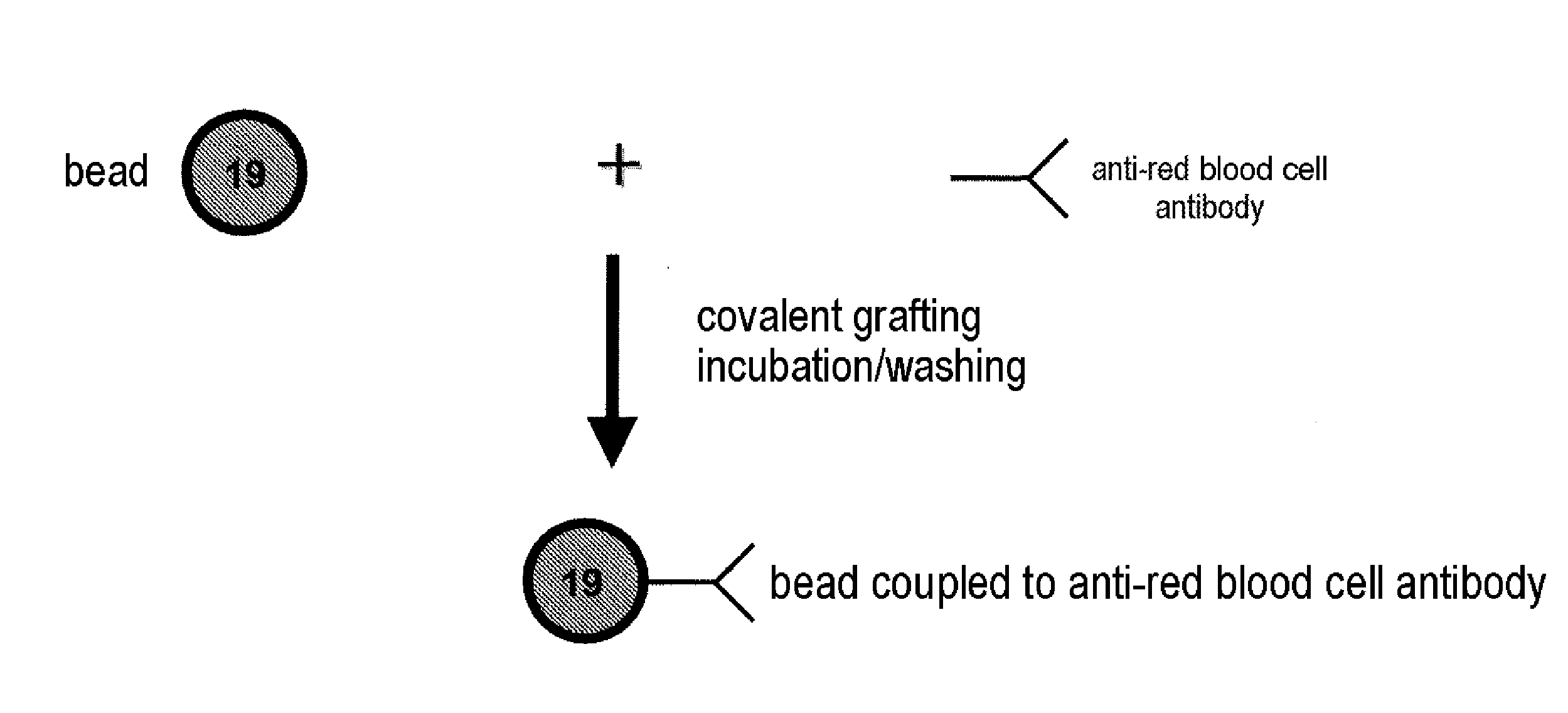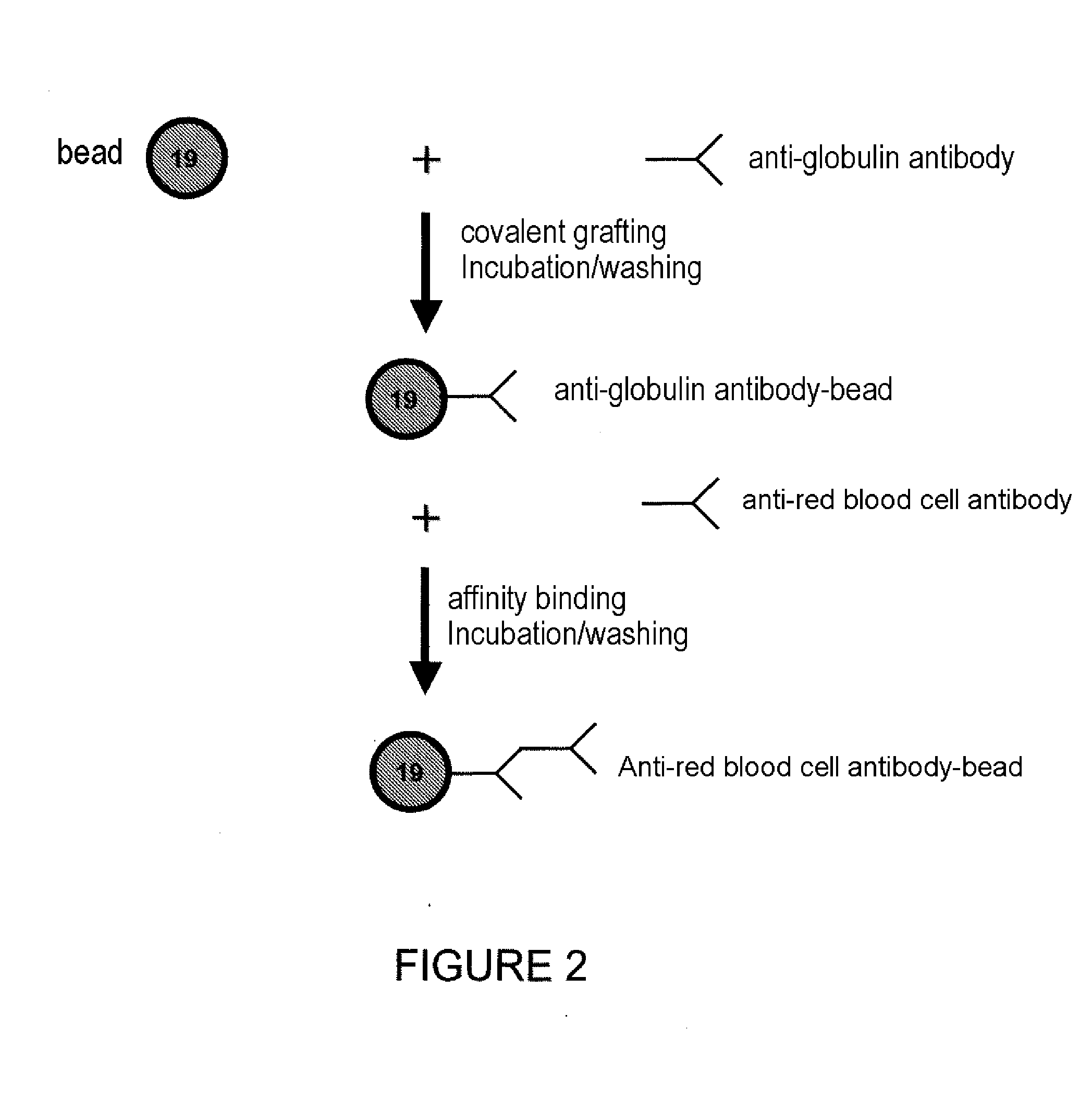Multiple Analysis of Blood Samples
a blood sample and multi-agent technology, applied in the field of multi-agent analysis of blood samples, can solve the problems of inability to determine specificity, inability to take into account all, and current techniques still have a certain number of limits, and achieve the effect of rapid and simpl
- Summary
- Abstract
- Description
- Claims
- Application Information
AI Technical Summary
Benefits of technology
Problems solved by technology
Method used
Image
Examples
example 1
Phenotyping and Grouping
[0116]The objective of this analysis is to identify, by means of specific monoclonal antibodies, the blood group antigens present at the surface of red blood cells from donors or from patients (group ABO, RH, Duffy, Kidd, Lewis, etc.).
[0117]In order to demonstrate the possibility of phenotyping / grouping red blood cells with the technology of the invention, fluorescent beads are used to immobilize the anti-red blood cell antibodies. Antibodies of different antigenic specificities can thus be bound to various regions of beads that have different colours.
[0118]As for the red blood corpuscles, they are labelled with a fluorescent compound compatible with the wavelengths of the reporter laser of the apparatus sold under the name “Bioplex 200” by the company Bio-Rad.
[0119]After labelling, the red blood cells are incubated with the sensitized beads. It is thus possible to detect the red blood cells attached to the beads and thus to determine their antigenic specific...
example 2
Atypical Antibody Screen Unitary and Multiplexed Methodology
[0182]The atypical antibody screen (AAS) is generally carried out according to the most sensitive methods (filtration through a gel sold by the company Bio-Rad in the “ScanGel” range, sold by the company Diamed under the name “Diamed ID”, or according to an immunoadhesion methodology in microplate format, sold by the company Immucor, Capture® range). In the first two cases, it uses red blood cells the phenotype of which is known and which are incubated with the serum or plasma sample to be examined. The specific antibodies, possibly present, bind to the surface of the red blood cells. They are subsequently revealed using a reagent containing an anti-human immunoglobulin antibody. In the case of a positive reaction, a red blood cell agglutinate is formed. If the reaction is negative, the red blood cells are free and no aggregate is formed. By using panels of red blood cells which have or do not have various antigens, it is t...
example 3
Cross Match
[0226]The objective of this analysis is to be sure that, in the context of a transfusion of one or more blood cell concentrates from donors to a recipient, there is complete donor-recipient compatibility and, where appropriate, to demonstrate an incompatibility linked to the presence of antibodies in the recipient's plasma, directed against blood group structures carried by the red blood cells of the donor(s).
[0227]In order to demonstrate the possibility of carrying out the cross match in the technology of the invention, fluorescent beads are used to immobilize the donor's red blood cells via poly-L-lysine (PLL). This immobilization is carried out by simple contact between the beads and the donor's red blood cells, for a minimum amount of time (5 min) and extemporaneously.
[0228]These beads are then placed in the presence of the recipient's plasma or serum. The possible presence of antibodies from the recipient directed against the donor's antigens is detected by an anti-F...
PUM
 Login to View More
Login to View More Abstract
Description
Claims
Application Information
 Login to View More
Login to View More - R&D
- Intellectual Property
- Life Sciences
- Materials
- Tech Scout
- Unparalleled Data Quality
- Higher Quality Content
- 60% Fewer Hallucinations
Browse by: Latest US Patents, China's latest patents, Technical Efficacy Thesaurus, Application Domain, Technology Topic, Popular Technical Reports.
© 2025 PatSnap. All rights reserved.Legal|Privacy policy|Modern Slavery Act Transparency Statement|Sitemap|About US| Contact US: help@patsnap.com



